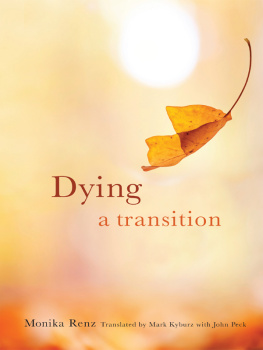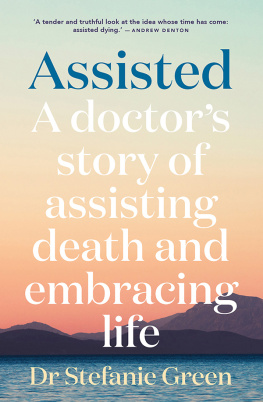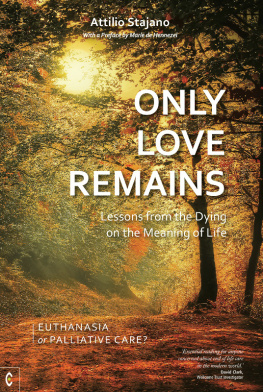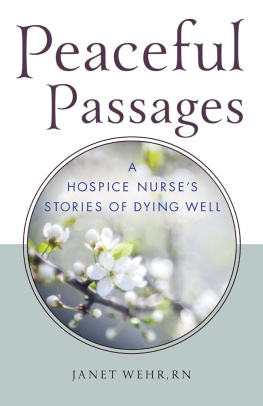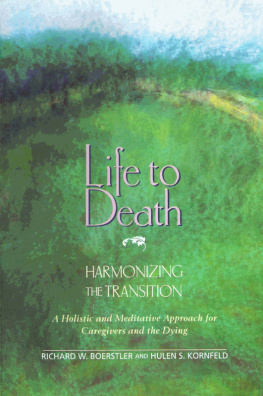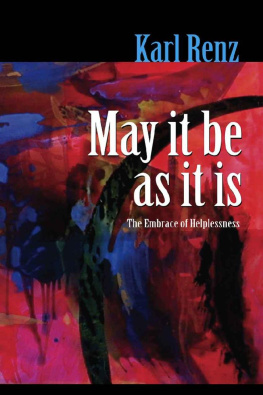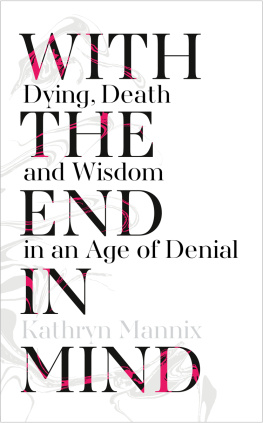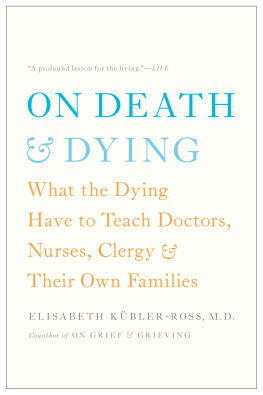DYING
END-OF-LIFE CARE: A SERIES
END-OF-LIFE CARE: A SERIES
SERIES EDITOR: KEITH ANDERSON
We all confront end-of-life issues. As people live longer and suffer from more chronic illnesses, all of us face difficult decisions about death, dying, and terminal care. This series aspires to articulate the issues surrounding end-of-life care in the twenty-first century. It will be a resource for practitioners and scholars who seek information about advance directives, hospice, palliative care, bereavement, and other death-related topics. The interdisciplinary approach makes the series invaluable for social workers, physicians, nurses, attorneys, and pastoral counselors.
The press seeks manuscripts that reflect the interdisciplinary, biopsychosocial essence of end-of-life care. We welcome manuscripts that address specific topics on ethical dilemmas in end-of-life care, death, and dying among marginalized groups; palliative care; spirituality; and end-of-life care in special medical areas, such as oncology, AIDS, diabetes, and transplantation. While writers should integrate theory and practice, the series is open to diverse methodologies and perspectives. Manuscript submissions should be sent to series editor Keith Anderson at .
Joan Berzoff and Phyllis R. Silverman, Living with Dying: A Handbook for End-of-Life Healthcare Practitioners
Virginia E. Richardson and Amanda S. Barusch, Gerontological Practice for the Twenty-first Century: A Social Work Perspective
Ruth Ray, Endnotes: An Intimate Look at the End of Life
Terry Wolfer and Vicki Runnion, eds., Dying, Death, and Bereavement in Social Work Practice: Decision Cases for Advanced Practice
Mercedes Bern-Klug, ed., Transforming End-of-Life Care in the Nursing Home: The Social Work Role
Dona J. Reese, Hospice Social Work
Allan Kellehear, The Inner Life of the Dying Person
DYING
A TRANSITION
MONIKA RENZ
TRANSLATED BY
MARK KYBURZ
WITH JOHN PECK
Columbia University Press New York
Columbia University Press
Publishers Since 1893
New York Chichester, West Sussex
cup.columbia.edu
Originally published as Hinbergehen: Was beim Sterben geschieht (2011) 2015 Kreuz Verlag
Translation copyright 2015 Columbia University Press
All rights reserved
E-ISBN 978-0-231-54023-0
Library of Congress Cataloging-in-Publication Data
Renz, Monika, 1961, auhor.
[Hinbergehen. English]
Dying : a transition / Monika Renz ; translated by Mark Kyburz with John Peck.
p. ; cm. (End-of-life care : a series)
Translation from German.
Translation of: Hinbergehen : was beim Sterben geschieht. 2014.
Includes bibliographical references and index.
ISBN 978-0-231-17088-8 (cloth : alk. paper)
ISBN 978-0-231-54023-0 (e-book)
I. Title. II. Series: End-of-life care.
[DNLM: 1. Attitude to Death. 2. Terminally Illpsychology. 3. Adaptation, Psychological. 4. Palliative Carepsychology. 5. Terminal Carepsychology. BF 789.D4]
R726.8
616.02'9dc23
2015008493
A Columbia University Press E-book.
CUP would be pleased to hear about your reading experience with this e-book at .
COVER IMAGE: Borut Trdina/Getty Images
COVER DESIGN: Diane Luger
References to websites (URLs) were accurate at the time of writing. Neither the author nor Columbia University Press is responsible for URLs that may have expired or changed since the manuscript was prepared.
CONTENTS
I AM DEEPLY GRATEFUL to everyone who has assisted me in bringing to publication the English edition of this book. My warm thanks to Dr. Keith Anderson, whose enthusiastic response to Dying Is a Transition (American Journal of Hospice and Palliative Medicine 30 [3]: 283290) made this book possible in the first place. I owe many thanks to Columbia University Press, especially to my translators, Dr. Mark Kyburz and Dr. John Peck; to Dr. Rudolf Walter, the editor of the original German edition of this book (Hinbergehen [Freiburg: Kreuz Verlag, 2011, 2015]); and to Dr. Miriam Schtt Mao, my research assistant, who supported and encouraged me time and again. I am most grateful to the following medical staff for their outstanding cooperation in the service of the patients in our care: Dr. Thomas Cerny, Department of Oncology, St. Gallen Cantonal Hospital; the palliative care physicians Drs. Florian Strasser and Daniel Bche; my fellow psychotherapist Michael Peus; and the palliative care teams St. Gallen and Mnsterlingen. I am indebted to the following individuals: Dr. Gisela Leyting, a practicing supervisor, psychiatrist, and psychoanalyst; Dr. Ursula Renz, Department of Philosophy, Klagenfurt University; Dr. Roman Siebenrock, Department of Theology, Innsbruck University; and Dr. Pim van Lommel, The Netherlands. I also extend my sincere thanks to my former teachers and colleagues, who were always prepared to discuss delicate questions in the areas of psychology and psychotherapy, theology, and spirituality. I owe special thanks to the many patients and relatives who shared their experiences with me. I wish to thank my family, my parents, my brothers and sisters. I would like to mention especially my mother for her critical comments and her unfailing support. My most personal heartfelt thanks go to my husband, Jrg!
W HAT IS GOOD DYING? Is it perhaps the sudden death suffered from an accident or a heart attack? Whereas such deaths spare us months of terminal illness and suffering, they come as a shock to family and friends, who are denied the opportunity of bidding farewell. Or is good dying a slow passing away and leave-taking, which asks patients and relatives to endure much suffering in approaching death? Do those who repress their emotions die well? Or is good dying to consciously experience life, suffering, and taking leave? Is life intensified and enhanced just because we are nearing its end? (see the notion of life embracing in Kellehear 2014).
and, I would add, at the risk of interfering with an inner, spiritual process. For many patients, relatives, and professionals, good dying is, above all based on careful and sometimes meticulous decision making. Good decision making facilitates all further interventions.
How can end-of-life care ensure a good death? Recently, rapid advances have been made in palliative medicine and palliative care, in particular in terms of the humanist approach (Pellegrino 2002), structured communication (Pantilat 2009), and symptom control (Smith et al. 2012). We now also better understand the processes of maturation and individuation that occur in connection with dying (Byock 1997; Kearney 1996; Patton 2006). Physicians and caregivers take their patients feelings seriously, as much as their helplessness (Sand 2008), their hopes, their ways of looking at the world, and their yearnings for spirituality (Balboni et al. 2010). Moreover, several therapy concepts centered on dignity, on the family, and on finding meaning have emerged (Breitbart et al. 2010; Chochinov et al. 2005; Gaeta and Price 2010; Nissim et al. 2012).
Yet notwithstanding these advances, attention remains focused on those needs of the dying that are expressed in words and that are thus more or less conscious. End-of-life care is, at present, mostly defined in terms of the rational, understanding (seeing), and self-determined individual. Even spiritual care is, at present, primarily focused on the expressed and conscious spiritual needs of patients (Holloway, Adamson, McSherry, and Swinton 2011:1927). Complex processes and symptoms like total pain, and their emotional and spiritual components (Strasser, Walker, and Bruera 2005), are readily diagnosed but largely considered only from the perspective of the ego and its ego-centered perception. By ego-centered, I do not mean egotistical but ego-basedthat is, related to the human subject. For Richard Rohr (2009), the main problem of this ego-centered perspective is its dualistic thinking that protects and pads the ego and its fear of change (94). What we are lacking, however, is a holistic understanding of dying processes including nonverbal and symbolic signals, the unconscious dimensions, and the fundamental processes and transformations experienced by the dying. There is a lack of knowledge about patients inner perspective and experiences. Where fear or despair prevail, where patients are suffering and distressed, when the dying process falters, then patients and their families need not only medical expertise, good communication skills, and spontaneous compassion but also therapeutic-spiritual care based on a deeper understanding of the unconscious dimension, and of dying as a transformation of perception comparable to near-death experience (Lommel 2010). We need a profound knowledge of (archetypal) spiritual processes, which happen when our everyday consciousness is transcended such as in dying processes, in spiritual experiences amid suffering, and in seeing as the mystics see (Rohr 2009). Such understanding enables a new quality of spiritual care and sometimes even guidance.

